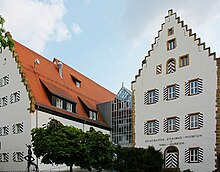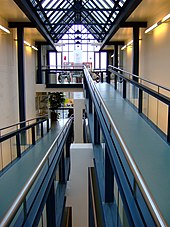German two-wheeler and NSU museum
The German Two-Wheeler and NSU Museum in Neckarsulm is located in the Teutonic Order Castle and was opened in 1956. It is the oldest motorcycle museum in Germany and one of the largest two-wheeler collections in the country. The museum shows a collection from the beginnings of the bicycle to historical motorcycles and modern racing machines.
With around 360 exhibits on almost 2000 m² and six floors, it is the largest historical collection of its kind in Germany. The NSU Museum documents the history of the NSU Motorenwerke brand .
History of the museum
In Neckarsulm, NSU was one of the first companies in the world to manufacture bicycles from 1886 and motorcycles from 1901. That is why the idea of building a two-wheeled museum in Neckarsulm was obvious. Another important reason was the two-wheeler crisis in the mid-1950s. Two-wheeled technology should be documented and handed down for future generations. With the support of NSU and the Deutsches Museum Munich , especially its department head Max Rauck, the German Bicycle Museum was set up in the former Teutonic Order Castle on the initiative of the Mayor at the time , Hans Hoffmann. It was ceremoniously opened on Whit Saturday, May 19, 1956. At that time the exhibition comprised around 70 exhibits, which were presented on 600 m². In 1971 there was the first special exhibition on the subject of world record vehicles. From 1956 to 1977 the museum had around half a million visitors.
The exhibition area and the number of exhibits have been continuously increased since the opening in 1956. In 1981, 200 exhibits were shown on 900 m² and in 1984 the area was expanded again to 1200 m². The NSU department opened in 1986 and the museum was given its current name: "German Two-Wheeler and NSU Museum". From 1989 the museum was rebuilt. The two historical buildings Bandhaus and Amtshaus (Palas) were connected by a modern steel and glass ramp staircase. The entire German Two-Wheeler and NSU Museum is barrier-free.
Since 1991, the German Two-Wheeler and NSU Museum has housed one of the largest two-wheeler collections in Germany and the largest public NSU collection in the world on an area of almost 2000 m² with 360 exhibits.
Permanent exhibitions
The German Two-Wheeler and NSU Museum divides the collection into six large departments on six floors: the NSU Museum, the motorcycle department, the bicycle department, the racing department, the Kreidler collection and the special exhibition area.

Motorcycle department
The motorcycle department shows a cross-section of the entire motorcycle history from 1885 to the present day with over 90 national and international brands. Among other things, many models from manufacturers such as: Adler , AJS , BMW , DKW , Douglas , Hercules , Honda , Horex , Husqvarna , Kawasaki , Kreidler , Maico , Mars , Megola , MZ , Norton , Opel , Puch , Scott , Standard , Triumph , Victoria , Vincent , Wanderer , Windhoff , Yamaha or Zündapp .
These well-known names are supplemented by rarities, some of which are unique, e.g. B. also a mega presentation with a racing, a sport and a street version.
Gottlieb Daimler and Wilhelm Maybach's so-called “riding car” was the first two -wheeled vehicle with a combustion engine , which they built into a two-wheeled wooden frame in 1885. The museum shows a replica of this "original motorcycle" from around 1900. At the same time, Carl Benz was showing off his three-wheeled motor vehicle in Mannheim . In the following years, the brothers Heinrich and Wilhelm Hildebrand experimented with Alois Wolfmüller and the mechanic Hans Geisenhof on motor-driven vehicles. In 1894 in Munich they constructed a two-wheeler with a tubular frame into which a horizontal two-cylinder engine was built. Wolfmüller and Geisenhof received the German Reich Patent No. 78553 for this vehicle in 1894, in which the name "motorcycle" was mentioned for the first time. This was the world's first mass-produced motorcycle. In the museum you can see the original of the test model - the so-called " Hildebrand and Wolfmüller " - from 1894 and one of the first production motorcycles. The further development of the motorcycle led through the stations of the "Neckarsulmer" built in 1901 by NSU -Werke AG and the 1922 Reichsfahrtmodell by DKW . Models of almost forgotten brands such as Cyklon , De Dion Bouton or Allright as well as highlights such as the Windhoff motorcycle from 1928, an Indian Four or a Nimbus motorcycle, to name just a few, are also on display.
There is also a Zündapp K800 that was used by the Wehrmacht, a BSA M20 that was used in the British Army as a motorcycle messenger motorcycle, and the legendary Kettenkrad HK 101 from NSU with an Opel engine, which was part of Rommel's Africa Corps . In addition to a Standard Rex Sport from 1935, a Sunbeam Model 9 or a Dresch 500 from 1930, the real highlight is a Brough Superior 11.50 from 1939, which is also known as the " Rolls-Royce " among motorcycles and was driven by Lawrence of Arabia .
Furthermore, motorcycles from the post-war period are presented. In particular, motor scooters like Lambretta, Vespa, DKW Hobby or Zündapp Bella can be seen here, which are grouped around a milk bar. In addition to German motorcycle brands such as Adler, Horex, Triumph, Victoria, and Zündapp, you will also find motorcycles from Italian companies - for example Bianchi and Ducati - and the probably best-known American company Harley-Davidson . Many Japanese motorcycle manufacturers such as Kawasaki, Yamaha and Honda are also exhibited. Highlights in this department include a Hercules Wankel 2000 with the innovative Wankel engine , a BMW K 1200 S from 2006 and a replica of a Harley Davidson "Easy Rider" from 1987 from the film of the same name with Peter Fonda.
NSU museum


The NSU Museum shows the company's development with selected exhibits. In the basement there is an overview of the history of the former world market leader in the sandstone vault.
The company founded by Christian Schmidt and Heinrich Stoll , which was relocated to Neckarsulm in 1880, initially produced knitting machines as well as bicycles from 1886 and motorcycles from 1901. NSU became the largest motorcycle factory in the world after the Second World War . In 1955, production reached its absolute peak with 350,000 motorized two-wheelers. In 1969 NSU merged with Auto Union GmbH to form Audi NSU Auto Union AG, which today operates under the name Audi AG .
The NSU Museum, formerly the official building, shows the beginnings of the company with the first penny farthing from 1886 and the development of motorcycles from 1901 to 1938 and two cars that were built before the Second World War. Highlights are successful racing motorcycles such as the pre-war internal combustion engines that the English racing driver Tom Bullus drove, or the Bullus with vertical shaft from Walter Moore . From post-war racing history there are u. a. a Sportmax from 1955 and a Rennfox "Blauwal" from 1954, with which Werner Haas became German champion and Rupert Hollaus became world champion.
The history of NSU in the 1950s and 1960s, in which the Neckarsulm-based company rose to become the world market leader in motorcycle construction, is presented in the Bandhaus. Here you can see the motorcycles of the Fox , Lux and Max series as well as the NSU Quickly , the best-selling moped in the world with 980,000 copies at the time. Cars are also on display here: including an NSU Prinz III from 1961 and an NSU Ro 80 with a Wankel engine from 1967.
Racing department
The racing department shows various racing motorcycles in a stylized steep path curve similar to the NSU entry lane. The compressor bolides from the 1930s and 1940s from BMW, DKW and NSU are particularly striking. These and other rarities were driven by Tom Bullus , Georg Meier , Heiner Fleischmann , Wilhelm Herz , H. P. Müller , Werner Haas , Dieter Braun , Toni Mang , Manfred Herweh, among others . Texts provide information about the history of racing and are supplemented by pictures and short portraits of famous racing drivers. This room also houses the “BMW Enduro” with which Gaston Rahier won the Paris-Dakar Rally in 1985, as well as a cement track racing machine, an ice speedway machine and other off-road motorcycles. Also noteworthy are the two dragsters by Dutchman Henk Vink . His rocket bike with a peroxide rocket motor with an output of 2000 hp can be accelerated to a speed of over 400 km / h.
Kreidler department
The German Two-Wheeler and NSU Museum presents the former works collection of the Kreidlermuseum Kornwestheim in a separate section. This has been anchored in the museum as a permanent loan since it was closed. In addition to the well-known everyday vehicles from Kreidler-Florett, the Swabian company's record-breaking vehicles can be admired. Also there is u. a. the so-called "Kreidler cigar" from 1965. With this Rudolf Kunz set several world speed records on the salt lakes of Utah (USA).
Bike department
The development of the bicycle is documented on over 45 models . This department begins with the first attempts by Karl Drais , who constructed his two-wheeled walking machine in 1817 . The Frenchman Pierre Michaux developed this idea further by equipping the previous running machine with a crank in the front wheel, which kept the two-wheeler in constant steady motion. The further change to the classic high bike by James Starley turned out to be a mistake. The decisive step in development came from John Kemp Starley , James Starley's nephew, who designed the original model of the modern bicycle in 1884. He shifted the drive to the rear wheel by transferring the torque of the crank to the rear wheel through a chain over two differently sized chain wheels and called this type of bicycle "Rover".
This development of the bicycle from the Drais' walking machine to high bikes in the 1880s to the first low-safety bicycles can be clearly followed. Further curiosities, developments of the most varied drive types (e.g. cardan drive on bicycles) to racing machines of the Tour de France and downhill champion bikes up to the current developments in the e-bike sector will be presented. In addition, the museum presents the first bicycles with an auxiliary motor from the beginning of the 20th century.
Special exhibitions
In the annually changing special exhibitions, individual motorcycle companies or epochs, building types, etc. are highlighted.
Cinema forum
The modern cinema forum presents the film “Bike Experience” every hour on the hour, which introduces the feeling of riding a motorcycle. The room also offers space for events.
Selected images
Zündapp KS 601 team on a world tour from February 19, 1952 to March 13, 1954 by Eitel and Rolf Lange
Publications
- Catalogs: two-wheel exotic vehicles _ exhibition brochures
- Catalog: Record hunting on two wheels, published by the German Two-Wheeler and NSU Museum, 2019
- Catalog: RENNLEGENDEN 1960–85, publisher. Deutsches Zweirad- und NSU-Museum Neckarsulm, 2020
literature
- Dr. Erhard Klotz: An idea started rolling. 25 years of the German Bicycle Museum Neckarsulm . Ed .: Stadtverwaltung Neckarsulm, 1981
Web links
Coordinates: 49 ° 11 ′ 29.6 ″ N , 9 ° 13 ′ 20.6 ″ E










